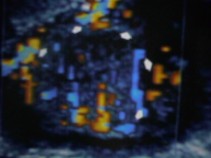Torsion of the testicle
I am familiar with this condition by virtue of personal experience and by virtue of working at a
small hospital, where practically all the studies are emergency examinations.
This is a devastating disease, which if not diagnosed promptly, will lead to loss of testicle. The
condition is most common in young adolescent boys. The typical history is that of acute onset of
severe unilateral scrotal pain, sometimes with swelling. The etiology of this condition is twisting
of the testicle on its pedicle, resulting in vascular compromise.
It is stated that once the vascular compromise begins, irreversible changes in the testicle occur in 6
to 12 hours. Watching and waiting is not an option. The urology literature suggest that if there is
strong clinical indication of testicular torsion, surgical exploration is the proper method to both
treat and to exclude the diagnosis.
However, in this age of high-technology, there are a host of studies that can be utilized to either
make or to exclude the diagnosis of testicular torsion. The main differential consideration is
epididymitis, an inflammatory condition. In testicular torsion, there is diminished blood flow to
the testicle. In epididymitis, there is normal blood flow to the testicle and increased blood flow to
the epididymis, a small structure which is situated superior and medial to the testicle. There are
other conditions such as trauma, neoplasm, varicocele, hydrocele, spermatocele, and torsion of the
appendix testis which also need to be considered when a patient presents with a mass or pain in
the scrotum.
The traditional test utilized to differentiate testicular torsion from epididymitis is a nuclear
testicular scan. Radioactive material is injected and images of the material are taken to
demonstrate flow and vascularity. The results of this study should be available within 30 minutes,
a reasonable period of time. The differentiation of testicular torsion is easily made on the basis of
diminished flow to the side of the pain, corresponding to the location of the testicle. In
epididymitis, increased flow will be seen on the side of the pain. Therefore it is critical to correlate
the result of this test with the location of the patients pain. Sometimes pictures are taken with
markers, to indicate the exact site of pain.
More recently, ultrasound examinations with utilization of color Doppler have been used to
differentiate various scrotal conditions. The problem with ultrasound is that it is highly dependent
on the operator, which is typically a nonphysician who generates pictures which are then
interpreted by a physician. In addition, younger boys sometimes have flow patterns which are
difficult to identify. The literature suggests a < 5 percent false negative rate in differentiating
testicular torsion from other conditions.
used to
differentiate various scrotal conditions. The problem with ultrasound is that it is highly dependent
on the operator, which is typically a nonphysician who generates pictures which are then
interpreted by a physician. In addition, younger boys sometimes have flow patterns which are
difficult to identify. The literature suggests a < 5 percent false negative rate in differentiating
testicular torsion from other conditions.
Color doppler image of testicle with flow.
The standard of care regarding the diagnosis and treatment of this condition allows very little
reason on the part of medical practitioners and hospitals to fail and allow for testicular loss.
Almost all hospitals now have ultrasound and nuclear medicine availability. Some smaller
hospitals have tried to limit access to this technology during regular daytime hours. However,
those of us who deal with emergencies on a regular basis know that emergency conditions do not
limit themselves to convenient hours. By law, emergency rooms must provide the same level of
care during the middle of the night as they do during the middle of the day. This pertains both to
the availability a physician specialties and diagnostic technology.
In summary, the standard of care for diagnosis and treatment of testicular torsion is high. The
failure to order tests to exclude the diagnosis and the failure to operate within a timely period can
result in testicular loss. Despite the fact that testicular loss generally does not affect fertility, case
law, at least in Florida, attaches are very high value to this loss. This in part is due to the
emotional appeal which is made to juries, regarding the future sufferings related to testicular loss,
which is the basis for determining damage.
 used to
differentiate various scrotal conditions. The problem with ultrasound is that it is highly dependent
on the operator, which is typically a nonphysician who generates pictures which are then
interpreted by a physician. In addition, younger boys sometimes have flow patterns which are
difficult to identify. The literature suggests a < 5 percent false negative rate in differentiating
testicular torsion from other conditions.
used to
differentiate various scrotal conditions. The problem with ultrasound is that it is highly dependent
on the operator, which is typically a nonphysician who generates pictures which are then
interpreted by a physician. In addition, younger boys sometimes have flow patterns which are
difficult to identify. The literature suggests a < 5 percent false negative rate in differentiating
testicular torsion from other conditions.